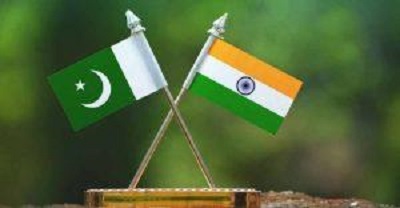Context
Speculation abounds on both sides of the Radcliffe Line regarding the potential for renewed engagement between India and Pakistan. Despite the uncertain efficacy of such a policy, recent developments and statements have fueled discussions on the possibility of re-engagement. The Ministry of External Affairs' (MEA) response to former Pakistan Prime Minister Nawaz Sharif’s comments about Pakistan violating the Lahore Declaration by initiating the Kargil conflict has particularly caught the attention of observers, suggesting that doors may reopen for dialogue after India's elections. However, this optimism may be misplaced given the current political and military stances of both countries.
Ties with Pakistan: Loose Talk or Opening the Latch?
The MEA's acknowledgment of a seemingly objective view emerging in Pakistan has been interpreted by some as a potential thaw in relations. This perspective has gained traction, especially with speculation that post-election, India might consider re-engagement with its neighbor. However, Prime Minister Narendra Modi has repeatedly stated his disinterest in pursuing relations with Pakistan, emphasizing that India’s development should not be hindered by its neighbor's actions. PM Modi has categorically dismissed the idea that his legacy might include normalizing relations with Pakistan, instead focusing on India's internal growth and future prosperity.
On the Pakistani side, civilian leaders like Nawaz Sharif occasionally express a desire to engage with India. However, the military, which holds significant power in Pakistan, maintains a belligerent stance. Recent declarations from Pakistan’s Formation Commanders not only reiterated support for Kashmir's self-determination but also criticized India's treatment of minorities, further complicating any prospects for re-engagement. The persistent nuclear rhetoric from Pakistan in response to the government's dismissal of their nuclear threats underscores the enduring tension.
Misplaced Optimism
The driving force behind the current optimism for re-engagement is unclear. Government Has maintained a consistent policy since the Uri terrorist attack in 2016, reinforced by actions such as the Balakot air strikes and the constitutional changes in Jammu and Kashmir in 2019. This approach involves keeping communication channels open while otherwise disengaging from Pakistan. Over the years, Pakistan has responded predictably to these developments, including downgrading diplomatic relations and halting trade, reinforcing India's decision to maintain a firm stance.
Pakistan, facing challenges on its western frontiers with Iran and Afghanistan and finding its relationship with China less transformative than expected, may see a need to engage with India. However, Pakistan's approach often involves selective engagement—seeking benefits like trade while continuing to support terrorism. Advocates for re-engagement within India argue that Pakistan might have learned from its past, suggesting India should at least test the waters. However, this perspective overlooks the fundamental issue: Pakistan's ongoing inimical attitude towards India. Re-engaging under these conditions risks reverting to ineffective past patterns and undoing recent gains.
Government Policy and the Re-engagement Advocacy
The government’s policy has effectively managed the complex dynamics with Pakistan. This strategy involves maintaining open communication lines but avoiding deeper engagement. Proponents of re-engagement argue that Pakistan’s recent statements, especially from civilian leaders, indicate a shift. However, these statements lack substantive actions to support a genuine change in Pakistan's stance.
The argument for re-engagement is often bolstered by clichés about the inevitability of dealing with one's neighbors. Yet, this perspective fails to address the practicalities of international relations. Indian politicians considering re-engagement might be motivated by electoral strategies rather than a coherent national policy. Despite calls for a policy shift, the government’s approach has shown results, particularly in managing Pakistan’s responses to India’s internal developments.
Pakistan's Dual Parallel Track Approach
If re-engagement occurs, Pakistan is likely to adopt a dual parallel approach. This strategy would involve engaging in talks and reopening trade while maintaining a simmering level of terrorism. Low-intensity attacks would continue to keep the jihad infrastructure active. Pakistan's strategy includes not just Kashmir but also efforts to destabilize Punjab through support for Khalistani elements. The Jamaat Islami's recent political activities in Jammu and Kashmir exemplify this dual approach, as they attempt to infiltrate the political system while disassociating from terrorism when under scrutiny.
In this dual-track approach, civilian leaders in Pakistan might present a façade of cooperation, while the military maintains a hardline stance. This tactic leverages the narrative that supporting civilians is crucial to prevent military destabilization. Indian leaders, influenced by Pakistani advocates within India, might fall for this ploy, potentially undermining national policy. Additionally, engaging with a fragile civilian government in Pakistan, which lacks real power, offers little strategic benefit and considerable risk.
Redux of ‘Mother India’ Complex?
Some argue that Pakistan's current crisis necessitates normalization with India, invoking the 'Mother India' complex. This perspective suggests that India's support could stabilize Pakistan. However, this argument lacks evidence and overlooks Pakistan's consistent hostility. The Pakistan Army's reluctance to open another front does not equate to a genuine desire for peace. Real indicators of change would include actions like ceasing support for terrorism in Kashmir, stopping incitement in Punjab, and addressing the presence of internationally recognized terrorists within Pakistan.
Without concrete actions from Pakistan, there is no reason to believe in a genuine shift towards peace. The next Indian government must continue the current policy, which has shown effectiveness over time. Changing this approach now would risk reversing significant gains. India's policy towards Pakistan should be pragmatic, devoid of emotional or nostalgic considerations. It must address both Pakistan as a hostile state and the pernicious mindset that fuels its actions.
Conclusion
India’s policy towards Pakistan has effectively managed a complex and often hostile relationship. Speculation about re-engagement, fueled by recent statements and developments, overlooks the fundamental issues that persist. While dialogue and trade might seem appealing, they risk reverting to ineffective past patterns. Any re-engagement must be approached with caution, ensuring that it does not undermine the significant gains made in recent years. A pragmatic, emotion-free policy that addresses both the state and the mindset of Pakistan is crucial for maintaining India's strategic interests and security.
|
Probable Questions for UPSC Mains Exam
|
Source – PIB, The Business Standard







